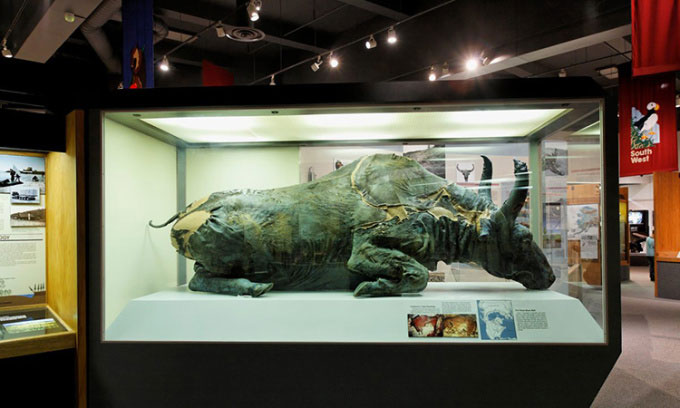In 1984, scientists enjoyed a peculiar dinner featuring a stew made from the meat of a long-frozen steppe bison.
In 1979, gold miners discovered a remarkably well-preserved mummy of a steppe bison (Bison priscus) in the Alaskan tundra and handed it over to scientists. At that time, the rare specimen was named Blue Babe and is the only known example of bison from the Pleistocene epoch excavated from permafrost. Dental and claw marks suggest that Blue Babe was likely killed by the ancestors of the American lion, Panthera leo atrox.

The Blue Babe bison displayed at the University of Alaska Museum of the North. (Photo: Patricia Fisher)
Initial collagen analyses indicated that Blue Babe lived approximately 36,000 years ago, but more recent studies have revised this estimate to 50,000 years. The rapid transformation into ice after death helped preserve the muscle tissue exceptionally well, comparable to that of dried beef, along with fat and bone marrow.
Researchers then decided to try using a portion of this unique specimen – the neck meat – to create a bison stew. This was not without precedent. They had heard of Russian scientists excavating frozen animals like bison and mammoths in the Far North that were preserved well enough to be eaten, as noted by editor Rachael Funnel in IFL Science on October 14.
“To celebrate and honor the work of Eirik Granqvist (a conservator and taxidermist) with Blue Babe, we had a dinner with bison stew for him and for Bjorn Kurten, who gave a presentation. A small portion from the neck of the bison mummy was sliced and simmered in a pot with vegetables and other ingredients,” wrote Dale Guthrie, who played a crucial role in the excavation of Blue Babe.
The unusual dinner took place at Guthrie’s home in Alaska. “We had Blue Babe for dinner. The meat was well-cooked but still a bit chewy, giving the stew a rich aroma reminiscent of the Pleistocene. Surely no one there would dare to miss it,” Guthrie stated.
“Making a neck steak didn’t seem like a good idea. But you know, we could add plenty of vegetables and spices, and it wouldn’t be too bad,” he explained regarding their choice of stew.
“When thawed, it released an unmistakable beef smell, mixed slightly with the faint scent of the surrounding earth, along with a hint of mushroom flavor. About ten of us gathered on April 6, 1984, to enjoy the bison stew,” Guthrie shared. He also mentioned that the flavor of the stew was delicious and that no one experienced any adverse effects from the meal.


















































